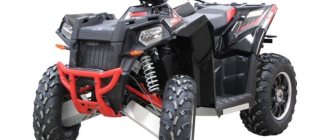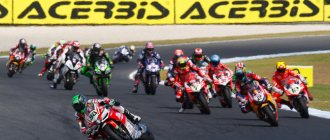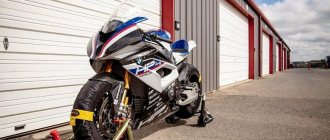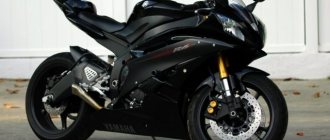BMW HP4 RACE
Year of manufacture 2017, 999 cm3, 215 hp, 171.4 kg.
Price: 5,400,000 rubles
Circulation: 750 copies
Text: Dmitry Osipov
Pilot: Gleb Koltsov
>>Bicycles with carbon frames have long been known not only to professional athletes, but also to wealthy lovers of pedaling, but carbon came to the world of motorcycles much later - only in 2017, two world-famous motorcycle manufacturers, BMW and Ducati, almost simultaneously presented serial versions of sportbikes with carbon frames. OK, maybe serial is too strong a word. The Ducati 1299 Superleggera will be limited to just 500 units, while the BMW HP4 RACE has no road homologation at all. And yet, the ice has broken!
At the end of June last year, BMW invited two lucky people from Russia to a presentation and test drive of its racing superbike of tomorrow. One of these lucky ones was my friend Gleb Koltsov, the 2015 Russian champion in the SBK EVO class. My role in this article is to tell you about the unique design elements of the German motorcycle, and Gleb, in turn, will share his impressions of the HP4 RACE, forever preserved in his memories.
Carbon skeleton.
The main feature of the BMW HP4 RACE is its monocoque frame, made of ultra-strong and lightweight carbon fiber using RTM (Resin Transfer Molding) technology. The same technology is used to produce bodies for the BMW i3 electric car and the BMW i8 hybrid sports car. Blanks made of dry carbon fiber are placed between two parts of special molds, after which the future part is sealed, and liquid resin is fed into the mold under pressure. The binding component displaces all the air, after which it polymerizes under the influence of temperature and turns into a durable composite. To create a beautiful glossy coating on the surfaces of the finished part and protect the composite material from moisture and ultraviolet radiation, another gel-like polymer is applied to the surface of the matrix - gelcoat. RTM technology also allows various fasteners and bearings to be embedded before molding, eliminating the need to drill holes in the finished part and thus increasing its strength.
The result is a seamless frame that is not only stiffer than the three-piece welded aluminum skeleton of the standard S1000RR, but also 4kg lighter. The wheels are naturally also made of carbon. They are 30% lighter than conventional forged ones and can withstand colossal shock loads, although the latter fact is not as relevant for a racing motorcycle as for a road motorcycle (especially taking into account Russian realities). The fairing elements are also carbon, and the “tail” and foam seat are mounted on a carbon subframe.
As a result, the motorcycle's dry weight is just 146 kg, and when fully fueled and ready for combat, it weighs only 171 kg. Simply put, it is lighter than the 400 cc sportbikes of the early 90s. The only negative is that due to the carbon frame and wheels (such modifications are prohibited in most championships), this racing motorcycle can only be used in a few tournaments, for example, the Macau Grand Prix or IRRC.
Gleb Koltsov: “An interesting nuance, carbon conducts heat very poorly. More precisely, it perfectly insulates the rider from the heat created by the 215-horsepower four-cylinder stove, and increases comfort during races on the track.”
Is there anything metal in this superbike? Of course, its liter four-cylinder engine is hand-built to international endurance racing specifications. It has “only” 215 hp. and 120 Nm of thrust, that is, 16 hp. and 7 Nm more than the standard S1000RR. However, if you think that this motor was simply freed from the environmental “collar” and reflashed, you are mistaken. It has new, stronger, hot isostatic pressed liners, and all-new milled connecting rods from the renowned Austrian company Pankl, connecting the standard S1000RR pistons to a 200-gram lighter and balanced crankshaft.
The head, naturally, has more aggressive camshafts, allowing for increased lift of the intake and exhaust valves; at the intake, there is a new manifold with optimized channels and servos, which, like on the stock S1000RR, allow the length of the channels to be shortened after 11,500 rpm, for maximum power . Naturally, this is not a complete list of the “chips” of this engine, but the most interesting thing is that according to the head of the BMW HP4 RACE project, Josef Makler, each such engine actually produces more than 215 horsepower from the wheel! That is, there should be about 230 forces on the flywheel, and this is not the level of endurance racing, but the level of a world superbike!
Gleb Koltsov: “I used to think that racing motorcycles at the WSBK level was very difficult. I thought they were tough and capricious. In fact, it turned out that with each lap I was getting more and more pleasure from the controls! I filmed second by second from the circle and did it playfully. The HP4 RACE is much easier to ride than the standard S1000RR, and the difference is simply colossal. And it’s not only about the most modern electronics, which help with acceleration, braking, and cornering, but also the overall balance of characteristics, the light and tractable chassis and the excellent responsiveness of the engine. The lightness, power and surgical precision of this motorcycle envelops you with its charm. When I switched from the HP4 RACE back to the S1000RR, the latter began to seem like a real bus to me!”
Now each HP4 RACE engine, prepared according to the 6.2 BMW Motorsport specification, can travel in combat modes for at least 5000 km (i.e. a season in the FIM EWC), and if there is a “vegetable” behind the wheel, at least 2 times more. After this, according to the regulations, the engine must be sent back to its homeland for rebuilding, which costs 12,500 euros.
World Superbike level components.
Of course, any motorcycle of this level is outstanding not due to one or two specific details, but only due to the totality of all components and settings. It would be stupid to compromise and use some half measures when building such a motorcycle - an “exhibition of brand achievements”, so BMW engineers went through the catalogs of top manufacturers of suspensions, brakes and all other peripheral elements and ordered the very best.
Thus, the handling of this superbike is ensured by an Öhlins FGR 300 inverted front telescopic fork and a TTX 36 GP monoshock absorber from the same Swedish brand. Such components can be found on most factory superbikes and prototypes competing in the WSBK and MotoGP championships. Light-alloy swingarms for the HP4 RACE are supplied by the company of the Swiss motorcycle racer and designer Eskil Suter; the same ones are used on the racing versions of the S1000RR.
Gleb Koltsov: “The habits of this motorcycle are similar to those of the S1000RR, only the HP4 RACE makes everything 10 times easier and faster. The speed of cornering is much higher, getting to the apex is much easier. The first impressions I got from the front end of the bike and the fork in particular are that it is very informative. I literally felt every stone. At the same time, we rode on hard Pirelli Diablo Superbike SC2 - tires that have never been famous for feedback.”
Thanks to the 215-horsepower engine and close-ratio transmission (according to Gleb, the key differences from the stock transmission appear in 4th gear), this carbon motorcycle accelerates to the very last gear faster than the cannonball that Baron Munchausen flew on. Naturally, all this unbridled kinetic energy needs to be absorbed somehow. The guys at BMW could have installed a brake chute, for example, but instead they opted for lightweight and insanely efficient Brembo GP4-PR (Production Racer) four-piston monobloc calipers, whose titanium pistons force Brembo Z04 pads into thick T-shaped 320mm Brembo brake discs . The GTZ with a cylinder diameter of 19 mm is borrowed from Moto2 racing bikes. Guess the manufacturer.
Gleb Koltsov: “I saw philistine reviews that they could have installed carbon brakes. But such braking systems are not only prohibitively expensive, but they also need to be able to be used correctly and constantly be kept in a high temperature range. Please note that even on MotoGP motorcycles, during rainy races, carbon brakes are replaced with classic steel ones.”
The most expensive BMW motorcycle: why the HP4 RACE is called engineering excellence
A bad equipment manufacturer is one who does not dream of creating the fastest, lightest, best motorcycle. We previously told how Ducati challenged itself to create a unique road-legal motorcycle, the Superleggera V4.
BMW also cherished the dream of creating the best motorcycle, and this is how their engineering excellence HP4 RACE was born, which is produced in limited numbers and hand-assembled. A total of 750 examples are planned, featuring a full carbon frame and carbon rims. It is known that only on a carbon frame a motorcycle loses 4 kilograms of weight. Thanks to the wheel rims, it drops another 1540 grams. As a result, the dry weight of the motorcycle is only 146 kilograms.
The project manager was Christian Gonschor. The first HP4 RACE motorcycles, called “engineering excellence”, were born in 2022 at the BMW Motorrad plant in Berlin. You will not find any turn signals, no additional lights, or a number frame on them. The engineers didn’t even consider installing anything unnecessary that doesn’t help you come first on the track. This motorcycle has only one goal - to show results.
The engine of the motorcycle is a 4-stroke, 4-cylinder, in-line engine with oil-liquid cooling and a displacement of 999 cc. Maximum torque 14,500 rpm. The engine produces 215 horsepower.
The engine is fed from a 17.5 liter gas tank. The aluminum tank is hand-satinised. The tank has a reserve of 4 liters.
BMW makes no secret of the fact that this is a track-only sportbike. The engine is run-in by specialists on a test bench prepared for this purpose, after which the results are recorded, and the first service is performed, including an oil change. Interestingly, the engine undergoes endoscopic examination, valve timing and valve clearances are adjusted. Thus, the brand new HP4 RACE bike is ready to be handed over to its new owner.
The six-speed gearbox has close ratios and HP RACE Pro gear shift assistant with a reverse shift pattern. Everything is as it should be for racing models.
And of course, a decent level of exhaust is provided by the all-titanium Akrapovic 4 x 2 x 1 WSBK system.
The 2D instrument panel provides all the information important to the driver and mechanics. The 2D recorder writes to memory and reads measured data. Users can fine-tune the DTC (Dynamic Traction Control) system to ensure excellent traction for every situation. Among the functionality, the driver can expect the ability to program engine braking (Engine Brake) and control the lifting of the front wheel (Wheelie Control), as well as a speed limiter in the pit lane (Pit-Lane Limiter) and an automatic acceleration function (Launch Control).
The motorcycle offers complete customization with a variety of adjustments, ranging from seat height to adjustable handlebar bend and footpegs. BMW also worked on ergonomics.
It is worth noting that the engineers used the maximum of developments used in world-class motorcycle racing. The motorcycle has an inverted FGR 300 Öhlins telescopic fork and a TTX 36 GP shock absorber.
Brembo GP4 PR brake calipers are responsible for safe and efficient braking, along with 6.75mm thick 320mm T-Type steel racing brake discs.
As they say at BMW, the motorcycle is designed for records. And the price for it is a record one. At the current exchange rate, perfection from BMW will cost from 5,492,000 rubles. For this money, the owner receives a “sports car” charged in every sense, created by the best minds of BMW.
Next generation electronics.
Naturally, the creators of the HP4 RACE simply did not face the issue of the cost of components, so the BMW superbike received a set of racing electronics that even NASA employees would envy. The regular S1000RR has the most modern ABS, which allows you to fly into corners in trail breaking, and smart traction control tied to the IMU, and anti-wheelie. But the HP4 RACE's electronics are on a completely different level. Firstly, almost each of the systems can be configured not only by the degree of intervention (DSC and EBR have 15 of them each), but also depending on the selected gear. And this is not surprising, because the ultra-light Bavarian superbike is capable of tearing the front wheel off the asphalt when accelerating up to 5th gear!
Any rider will be able to find the right balance of adjustments for themselves. An inexperienced pilot will set the values to maximum and will feel completely safe, while a professional will be able to reduce the traction intervention in order to exit corners more aggressively - in a slide. The HP4 RACE also has such useful features as the Launch Control function, a speed limiter in the pit lane and a 2D data logger connected to a GPS transmitter and allowing you to save all readings during a race on the track. If you're not a tech geek, you might have to make friends with a WSBK or MotoGP race engineer to make sense of all this information, but for those with a more professional approach, a datalogger will be an invaluable assistant.
Gleb Koltsov: “The traction control is radically different from what is on the standard S1000RR. On the HP4 Race, when the traction control intervenes, you will not notice anything except the popping of the exhaust system due to misfires, it works so delicately and subtly, literally as if it is connected with you at the subconscious level.”
Hello, good people! One way or another, spring is coming to us. I can’t help but congratulate everyone on the start of the new season. And with that, I had the opportunity to feel my hands on the new “who gives a damn” - BMW S1000RR HP4.
With your permission, I will begin a series of articles about the electronic gadgets of HP4 (a mixture of a manual with a personal assessment and other articles from the open spaces) in which I will try to describe this “teleport”, as one of the commentators on my previous essay very wittily called it. I hope these letters will be useful to those who are rushing about making a choice before purchasing, to those who want to learn about modern assistants installed on motorcycles, and to simply curious people. There was a lot of material and therefore I divided it into 3 parts: the first - a general description of the “coolness” of the device, a description of the control elements, functions and useful features - without this chapter, it seems to me, the understanding of the need for the systems described later will not be complete; the second is the modes of the motorcycle and the systems with which it is abundantly compacted; and finally, there will be a couple of videos and a purely personal opinion about the work of the one described above and a review of the motorcycle in general.
PS Some of the material may be familiar to Bikepost readers (especially in terms of descriptions of HP4 modes), so you can simply not read anything that is superfluous. I didn’t throw out a piece of information from the overall picture. Criticism is welcome.
So why HP4?
Fetishists are foaming at the mouth about anodized forged wheels, electronic sensors crammed throughout the motorcycle, square meters of carbon fiber and a capped passenger seat. Although in general terms the HP4 is practically a copy of the S1000RR. The only “advantage” for the HP4 engine was the addition of power in the mid-range of engine speeds, and that was only thanks to the racing exhaust system from the well-known Igor Akrapovich. In fact, the feature of the motorcycle is only in the “brains” and one or two systems that are new for a serial motorcycle conveyor.
So, the BMW S1000RR HP4 is perhaps the most striking representative of the “ready to race” motorcycles currently available for sale.
List of key technological features of HP4
- Fork clamp with engraved number and HP4 logo - Lightest 4-cylinder supersport motorcycle in the 1000 cc segment cm: 199 kg (90% fuel tank full, unloaded weight according to DIN standard) - Innovative suspension with DDC (Dynamic Damping Control) - Race ABS with IDM setting - DTC (Dynamic Traction) Control) with fine adjustment in Slick mode - Launch Control function - Adapted front wheel lift detection system - New rear tires, 200/55 ZR 17 - Shift assistant as standard - Lightweight titanium exhaust system with controlled acoustic valve and - Forged alloy wheels with black anodized finish - Radial monobloc Brembo brake calipers with special brake pads - Floating front brake discs - Extended two-piece engine spoiler - Single seat with cover for passenger seat - LED turn signals - Tinted windshield - Lightweight 7 Ah battery - Dynamic engine tuning - Increased mid-range torque
HP4 with Competition package
- Extended, enclosed carbon engine spoiler - Sponsor logo decal kit - Racing blue metallic rims - Carbon fairing kit with HP logo - HP carbon fuel tank cover - HP brake lever, foldable - HP clutch lever, foldable - Adjustable steering system HP footrests for pilot
Buttons
Left steering switch block 1 High beam and intermittent light signal 2 ABS control / DTC control 3 Hazard warning light control DTC setting 5 Turn 6 Horn 7 / Trim meter control / Racing-sport functions control / Setting shock absorber stiffness
Right steering wheel switch block
1 Heated grip control 2 Driving mode selection 3 Emergency ignition switch 4 Engine start / Launchcontrol
Instrument cluster
1 Panel of control and warning lamps 2 Tachometer 3 Tachometer indicator 4 Light sensor (automatically adjusts the brightness of the instrument panel backlight) with system 5 Multi-function display
Multi -function display
1 Speedometer 2 Coolant temperature 3 grip indicator 4 5 Clock 6 driving mode 7 Set DTC degree (only in SLICK mode) 8 Selected gear indicator, “N” is displayed when neutral is on. 9 Selecting driving mode The display information for the race track is activated separately.
Functions and useful features
Maintenance indicator
If the time remaining until the next maintenance does not exceed a month, the maintenance date appears briefly on the display after the Pre-Ride Check is completed.
If annual mileage is high, unscheduled maintenance may be required due to certain circumstances. If the distance for a remote service is within 1000 km, the remaining 2 kilometers are counted in 100 km increments and appear briefly on the display at the end of the Pre-Ride Check. If the maintenance period is exceeded, in addition to the date or mileage indication, the general warning lamp lights up in yellow. The message “TO” according to the Inspection regulations is constantly displayed. If the maintenance indicator is displayed more than a month before the maintenance date, then you need to set the date entered in the instrument cluster. This situation may occur if the battery has been disconnected for a long time.
Power reserve
The range shows how far you can still travel with the remaining fuel. It is only displayed once the fuel reserve has been reached. The calculation is based on average consumption and fuel filling level. If refueling is carried out after the lower fuel reserve limit has been exceeded, the total amount of fuel must be greater than the reserve and a new filling level is recognized. Otherwise, the power reserve display cannot be updated. If the motorcycle is placed on a side stand, the fuel quantity may not be determined correctly due to its tilted position. For this reason, the range is always calculated with the side stand folded. The calculated range is always an approximate value.
Odometer
The following values can be shown on the display:
— Total mileage — Single mileage 1 (Trip 1) — Single mileage 2 (Trip 2) — Cruising range (after reaching the fuel reserve)
Watch
Watches and watches in Africa, in general they are here.
Speed Threshold Warning Allows you to set the speed above which a warning will appear. If the set speed is exceeded, the tachometer indicator lights up or starts flashing at the set frequency and a warning appears.
Pre-Ride-Check
After turning on the ignition, the instrument cluster checks the warning lights and tachometer - “Pre-Ride-Check”. If the engine starts before the test is completed, the test is interrupted. The beauty is that any problem with a motorcycle in the sense of a non-working system or equipment will be described by a specific light bulb or their combination.
Circle Time
Possible data display options:
Time taken to complete the previous “LASTLAP” lap. Time of movement in the current circle. Fastest Saved Lap "BESTLAP" Fastest Lap Expected Sum of all recorded lap times Absolute Best Lap Time Maximum Speed and Minimum Speed of Displayed Race Lap Average Percentage Throttle Position, Percentage of Driving with Brake Pressed, and Number of Gear Shifts of Displayed Race Lap circle
At the start of each new lap of the race, the stopped time of the previous race lap is briefly displayed before switching to the time of the current race lap. After starting a new lap, an intermediate time is recorded every 100 m and compared with the corresponding time of the saved best lap. If the current split time is better than the split time of the best lap, then the wait for a new best time begins. The “Fastest lap” lamp turns on 1.
Additional functions for displaying system and unit settings
Rear shock absorber rebound stage (REB DDC-RE) Rear shock absorber compression stage (COM DDC-RE) Front shock absorber stiffness (DMP DDC-FR) Front shock absorber rebound stage (REB DDC-FR) Front shock absorber compression stage (COM DDC-FR) Calibration level sensor (DDC-CAL) Rotation speed for turning on/off the tachometer indicator (SFT-ON/STF-OFF) Tachometer indicator brightness (SFT-BR) Tachometer indicator flashing frequency (SFT-FL) Display backlight brightness (BRIGHT)
*A description of the indications of other systems will be given in the description of them.
This concludes the first article about HP4 electronic assistants. You can kick.











